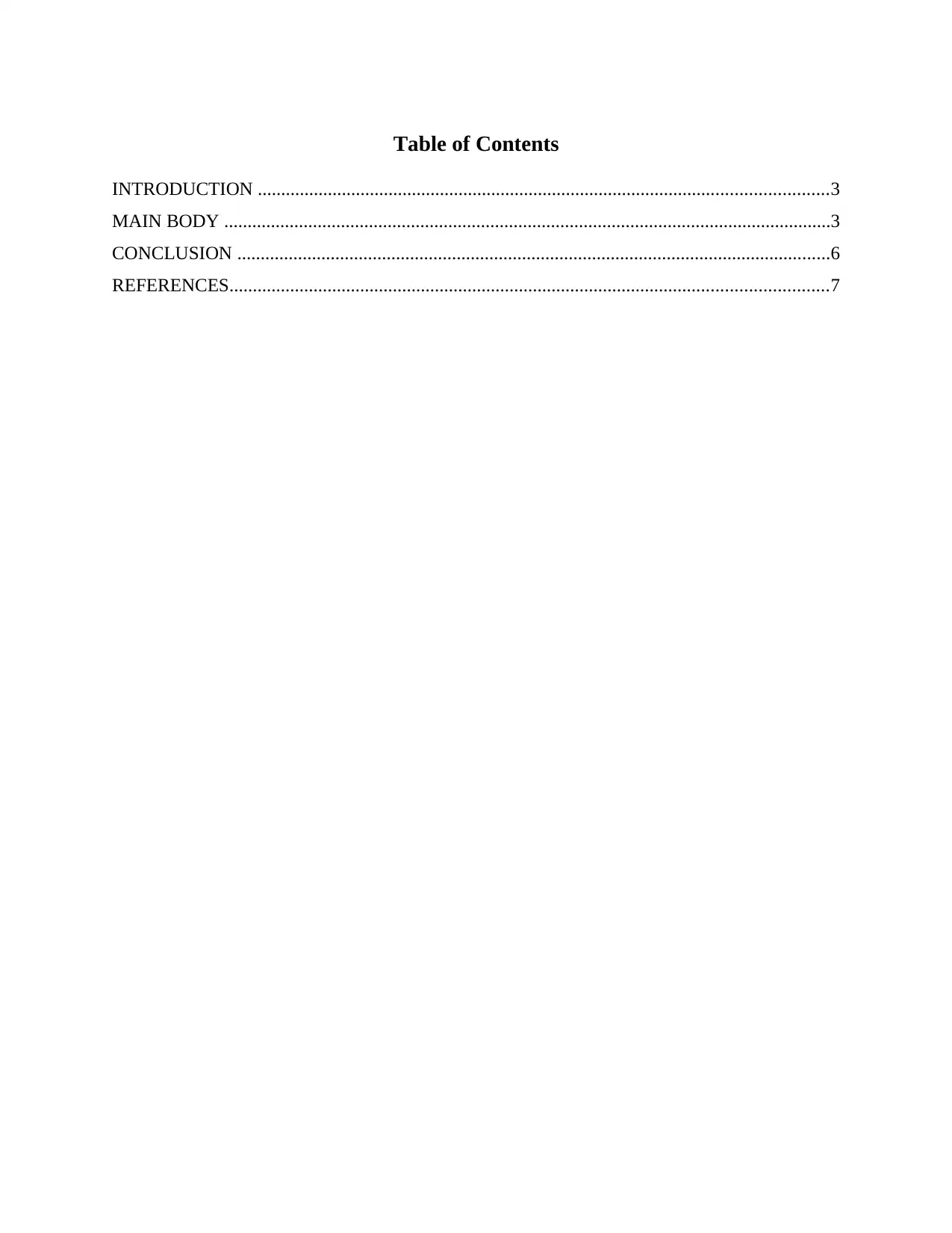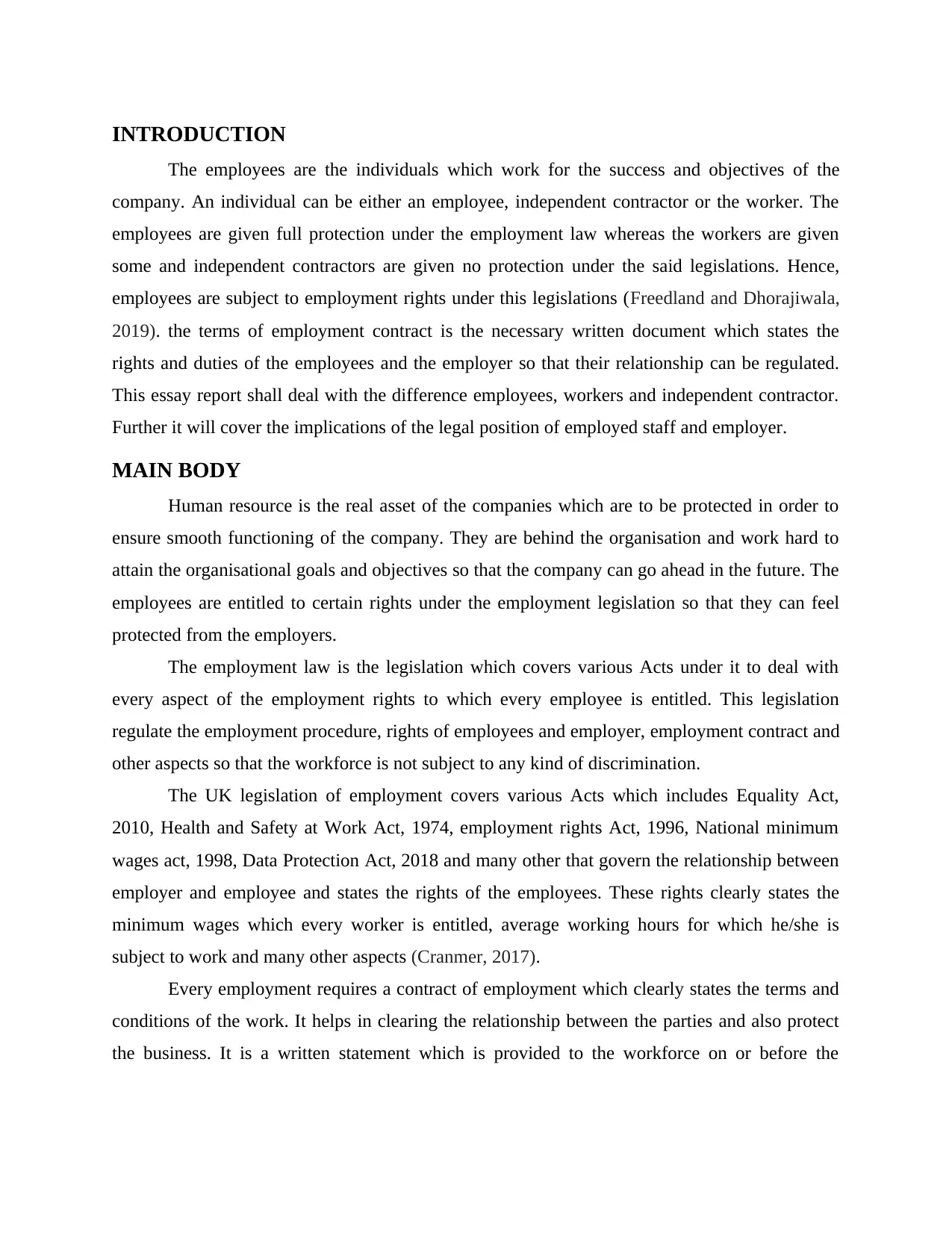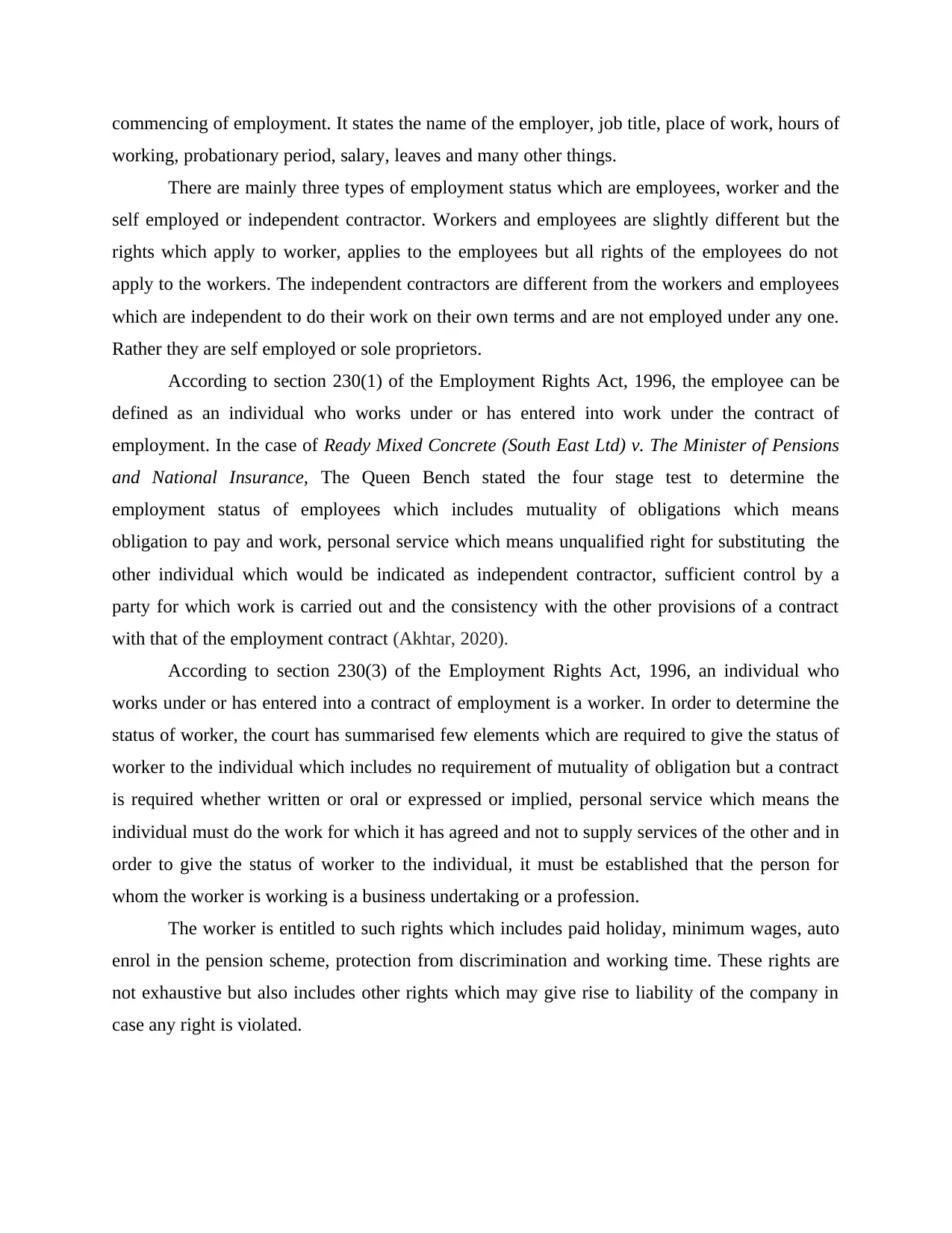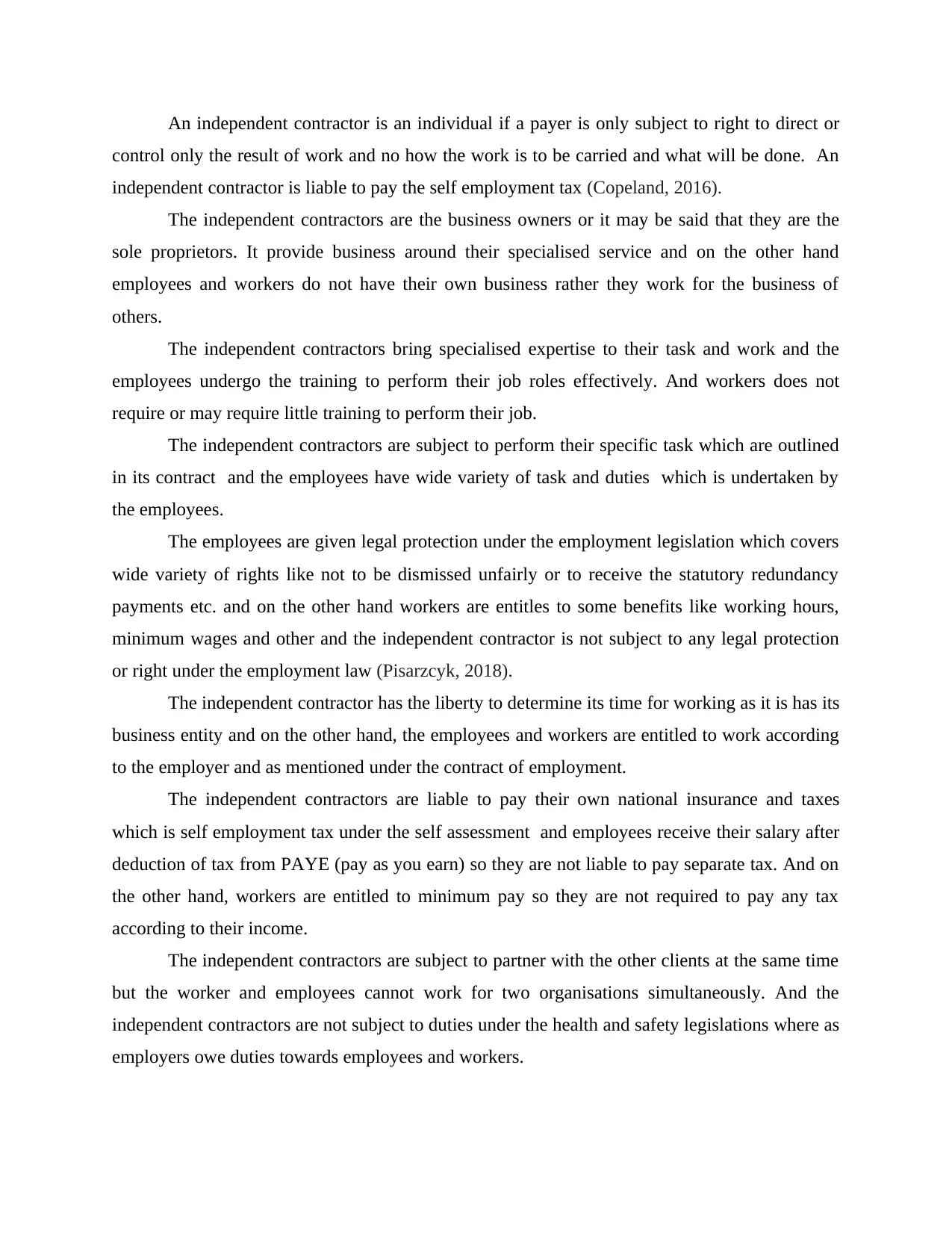Employment Law: Employee, Worker, and Contractor Rights and Duties
VerifiedAdded on 2023/01/05
|8
|2035
|26
Report
AI Summary
This report delves into the intricacies of UK employment law, focusing on the distinctions between employees, workers, and independent contractors. It explores the legal definitions of each employment status, referencing key legislation like the Employment Rights Act 1996 and the Equality Act 2010. The report outlines the rights and duties associated with each category, including entitlements to minimum wage, working hours, and protection against discrimination. It examines the role of employment contracts in defining the relationship between employers and employees, highlighting the implications for both parties. Furthermore, the report discusses the legal implications of misclassifying employment status and the importance of understanding these differences for both employers and employees. The analysis includes a comparison of the tax liabilities and legal protections afforded to each type of worker, offering a comprehensive overview of the UK employment landscape. The report concludes by summarizing the key differences and the impact of employment law on the workplace.

Employment law
Paraphrase This Document
Need a fresh take? Get an instant paraphrase of this document with our AI Paraphraser

Table of Contents
INTRODUCTION ..........................................................................................................................3
MAIN BODY ..................................................................................................................................3
CONCLUSION ...............................................................................................................................6
REFERENCES................................................................................................................................7
INTRODUCTION ..........................................................................................................................3
MAIN BODY ..................................................................................................................................3
CONCLUSION ...............................................................................................................................6
REFERENCES................................................................................................................................7

INTRODUCTION
The employees are the individuals which work for the success and objectives of the
company. An individual can be either an employee, independent contractor or the worker. The
employees are given full protection under the employment law whereas the workers are given
some and independent contractors are given no protection under the said legislations. Hence,
employees are subject to employment rights under this legislations (Freedland and Dhorajiwala,
2019). the terms of employment contract is the necessary written document which states the
rights and duties of the employees and the employer so that their relationship can be regulated.
This essay report shall deal with the difference employees, workers and independent contractor.
Further it will cover the implications of the legal position of employed staff and employer.
MAIN BODY
Human resource is the real asset of the companies which are to be protected in order to
ensure smooth functioning of the company. They are behind the organisation and work hard to
attain the organisational goals and objectives so that the company can go ahead in the future. The
employees are entitled to certain rights under the employment legislation so that they can feel
protected from the employers.
The employment law is the legislation which covers various Acts under it to deal with
every aspect of the employment rights to which every employee is entitled. This legislation
regulate the employment procedure, rights of employees and employer, employment contract and
other aspects so that the workforce is not subject to any kind of discrimination.
The UK legislation of employment covers various Acts which includes Equality Act,
2010, Health and Safety at Work Act, 1974, employment rights Act, 1996, National minimum
wages act, 1998, Data Protection Act, 2018 and many other that govern the relationship between
employer and employee and states the rights of the employees. These rights clearly states the
minimum wages which every worker is entitled, average working hours for which he/she is
subject to work and many other aspects (Cranmer, 2017).
Every employment requires a contract of employment which clearly states the terms and
conditions of the work. It helps in clearing the relationship between the parties and also protect
the business. It is a written statement which is provided to the workforce on or before the
The employees are the individuals which work for the success and objectives of the
company. An individual can be either an employee, independent contractor or the worker. The
employees are given full protection under the employment law whereas the workers are given
some and independent contractors are given no protection under the said legislations. Hence,
employees are subject to employment rights under this legislations (Freedland and Dhorajiwala,
2019). the terms of employment contract is the necessary written document which states the
rights and duties of the employees and the employer so that their relationship can be regulated.
This essay report shall deal with the difference employees, workers and independent contractor.
Further it will cover the implications of the legal position of employed staff and employer.
MAIN BODY
Human resource is the real asset of the companies which are to be protected in order to
ensure smooth functioning of the company. They are behind the organisation and work hard to
attain the organisational goals and objectives so that the company can go ahead in the future. The
employees are entitled to certain rights under the employment legislation so that they can feel
protected from the employers.
The employment law is the legislation which covers various Acts under it to deal with
every aspect of the employment rights to which every employee is entitled. This legislation
regulate the employment procedure, rights of employees and employer, employment contract and
other aspects so that the workforce is not subject to any kind of discrimination.
The UK legislation of employment covers various Acts which includes Equality Act,
2010, Health and Safety at Work Act, 1974, employment rights Act, 1996, National minimum
wages act, 1998, Data Protection Act, 2018 and many other that govern the relationship between
employer and employee and states the rights of the employees. These rights clearly states the
minimum wages which every worker is entitled, average working hours for which he/she is
subject to work and many other aspects (Cranmer, 2017).
Every employment requires a contract of employment which clearly states the terms and
conditions of the work. It helps in clearing the relationship between the parties and also protect
the business. It is a written statement which is provided to the workforce on or before the
⊘ This is a preview!⊘
Do you want full access?
Subscribe today to unlock all pages.

Trusted by 1+ million students worldwide

commencing of employment. It states the name of the employer, job title, place of work, hours of
working, probationary period, salary, leaves and many other things.
There are mainly three types of employment status which are employees, worker and the
self employed or independent contractor. Workers and employees are slightly different but the
rights which apply to worker, applies to the employees but all rights of the employees do not
apply to the workers. The independent contractors are different from the workers and employees
which are independent to do their work on their own terms and are not employed under any one.
Rather they are self employed or sole proprietors.
According to section 230(1) of the Employment Rights Act, 1996, the employee can be
defined as an individual who works under or has entered into work under the contract of
employment. In the case of Ready Mixed Concrete (South East Ltd) v. The Minister of Pensions
and National Insurance, The Queen Bench stated the four stage test to determine the
employment status of employees which includes mutuality of obligations which means
obligation to pay and work, personal service which means unqualified right for substituting the
other individual which would be indicated as independent contractor, sufficient control by a
party for which work is carried out and the consistency with the other provisions of a contract
with that of the employment contract (Akhtar, 2020).
According to section 230(3) of the Employment Rights Act, 1996, an individual who
works under or has entered into a contract of employment is a worker. In order to determine the
status of worker, the court has summarised few elements which are required to give the status of
worker to the individual which includes no requirement of mutuality of obligation but a contract
is required whether written or oral or expressed or implied, personal service which means the
individual must do the work for which it has agreed and not to supply services of the other and in
order to give the status of worker to the individual, it must be established that the person for
whom the worker is working is a business undertaking or a profession.
The worker is entitled to such rights which includes paid holiday, minimum wages, auto
enrol in the pension scheme, protection from discrimination and working time. These rights are
not exhaustive but also includes other rights which may give rise to liability of the company in
case any right is violated.
working, probationary period, salary, leaves and many other things.
There are mainly three types of employment status which are employees, worker and the
self employed or independent contractor. Workers and employees are slightly different but the
rights which apply to worker, applies to the employees but all rights of the employees do not
apply to the workers. The independent contractors are different from the workers and employees
which are independent to do their work on their own terms and are not employed under any one.
Rather they are self employed or sole proprietors.
According to section 230(1) of the Employment Rights Act, 1996, the employee can be
defined as an individual who works under or has entered into work under the contract of
employment. In the case of Ready Mixed Concrete (South East Ltd) v. The Minister of Pensions
and National Insurance, The Queen Bench stated the four stage test to determine the
employment status of employees which includes mutuality of obligations which means
obligation to pay and work, personal service which means unqualified right for substituting the
other individual which would be indicated as independent contractor, sufficient control by a
party for which work is carried out and the consistency with the other provisions of a contract
with that of the employment contract (Akhtar, 2020).
According to section 230(3) of the Employment Rights Act, 1996, an individual who
works under or has entered into a contract of employment is a worker. In order to determine the
status of worker, the court has summarised few elements which are required to give the status of
worker to the individual which includes no requirement of mutuality of obligation but a contract
is required whether written or oral or expressed or implied, personal service which means the
individual must do the work for which it has agreed and not to supply services of the other and in
order to give the status of worker to the individual, it must be established that the person for
whom the worker is working is a business undertaking or a profession.
The worker is entitled to such rights which includes paid holiday, minimum wages, auto
enrol in the pension scheme, protection from discrimination and working time. These rights are
not exhaustive but also includes other rights which may give rise to liability of the company in
case any right is violated.
Paraphrase This Document
Need a fresh take? Get an instant paraphrase of this document with our AI Paraphraser

An independent contractor is an individual if a payer is only subject to right to direct or
control only the result of work and no how the work is to be carried and what will be done. An
independent contractor is liable to pay the self employment tax (Copeland, 2016).
The independent contractors are the business owners or it may be said that they are the
sole proprietors. It provide business around their specialised service and on the other hand
employees and workers do not have their own business rather they work for the business of
others.
The independent contractors bring specialised expertise to their task and work and the
employees undergo the training to perform their job roles effectively. And workers does not
require or may require little training to perform their job.
The independent contractors are subject to perform their specific task which are outlined
in its contract and the employees have wide variety of task and duties which is undertaken by
the employees.
The employees are given legal protection under the employment legislation which covers
wide variety of rights like not to be dismissed unfairly or to receive the statutory redundancy
payments etc. and on the other hand workers are entitles to some benefits like working hours,
minimum wages and other and the independent contractor is not subject to any legal protection
or right under the employment law (Pisarzcyk, 2018).
The independent contractor has the liberty to determine its time for working as it is has its
business entity and on the other hand, the employees and workers are entitled to work according
to the employer and as mentioned under the contract of employment.
The independent contractors are liable to pay their own national insurance and taxes
which is self employment tax under the self assessment and employees receive their salary after
deduction of tax from PAYE (pay as you earn) so they are not liable to pay separate tax. And on
the other hand, workers are entitled to minimum pay so they are not required to pay any tax
according to their income.
The independent contractors are subject to partner with the other clients at the same time
but the worker and employees cannot work for two organisations simultaneously. And the
independent contractors are not subject to duties under the health and safety legislations where as
employers owe duties towards employees and workers.
control only the result of work and no how the work is to be carried and what will be done. An
independent contractor is liable to pay the self employment tax (Copeland, 2016).
The independent contractors are the business owners or it may be said that they are the
sole proprietors. It provide business around their specialised service and on the other hand
employees and workers do not have their own business rather they work for the business of
others.
The independent contractors bring specialised expertise to their task and work and the
employees undergo the training to perform their job roles effectively. And workers does not
require or may require little training to perform their job.
The independent contractors are subject to perform their specific task which are outlined
in its contract and the employees have wide variety of task and duties which is undertaken by
the employees.
The employees are given legal protection under the employment legislation which covers
wide variety of rights like not to be dismissed unfairly or to receive the statutory redundancy
payments etc. and on the other hand workers are entitles to some benefits like working hours,
minimum wages and other and the independent contractor is not subject to any legal protection
or right under the employment law (Pisarzcyk, 2018).
The independent contractor has the liberty to determine its time for working as it is has its
business entity and on the other hand, the employees and workers are entitled to work according
to the employer and as mentioned under the contract of employment.
The independent contractors are liable to pay their own national insurance and taxes
which is self employment tax under the self assessment and employees receive their salary after
deduction of tax from PAYE (pay as you earn) so they are not liable to pay separate tax. And on
the other hand, workers are entitled to minimum pay so they are not required to pay any tax
according to their income.
The independent contractors are subject to partner with the other clients at the same time
but the worker and employees cannot work for two organisations simultaneously. And the
independent contractors are not subject to duties under the health and safety legislations where as
employers owe duties towards employees and workers.

The employer and employee holds a relationship according to their contract of
employment which states the terms and conditions of the work. This contract clearly states the
rights and duties of the employees and employer. The employment law govern their relationship
and provide protection to the employees from any discrimination or other malpractices. In case
an employer discriminates and employee from other on the basis of gender or race, then the legal
implication is positive and the employer may be subject to liability under the Equality Act, 2010
(Easdale, 2018). Another legal implication includes the duty of employer to draft a termination
letter to the employee when firing it.
The employment law also regulate the relationship of employer and employees. It states
the rights, duties and liabilities of the employer and employee in order to regulate their
relationship. The employment law is a vast code which includes different legislations in it that
govern the rights of the employees (Shackleton, 2016). The employees gets protection from the
unfair dismissal under the employment rights act and the health and safety legislations imposes
statutory duty on the employer to comply with all the safety measures in the workplace so that
safety can be ensured in the company and employees work in safe and healthy environment.
The National Minimum Wages Act regulate the minimum pay of the employee to which
he/she is entitled. This law imposes the duty on employer and the right of the employee that
he/she is subject to a minimum pay for the work (Lewis and Sargeant, 2019). The Equality act of
2010 prohibits discrimination on any ground so that equality can be maintained and employees
also feel protected.
CONCLUSION
It is concluded from the above essay report that employment law govern the relationship
of employee and employer and imposes duty and liability on employer in case nay of the rights
of the employee is infringed. The term employee, workers and independent contractors are used
in same context but are different from each other. They are differentiated between each other on
the basis of many factors like meaning, tax liability, employment contract, rights under
employment law and many other. The independent contractors care not subject to any right under
the said legislation where as the worker is subject to some rights and the employee is entitled to
all the rights for its protection. Further the employer and its employed staff have a relationship
which is regulated by the contract of employment. Their legal position is implied from the
legislation of employment and their employment contract.
employment which states the terms and conditions of the work. This contract clearly states the
rights and duties of the employees and employer. The employment law govern their relationship
and provide protection to the employees from any discrimination or other malpractices. In case
an employer discriminates and employee from other on the basis of gender or race, then the legal
implication is positive and the employer may be subject to liability under the Equality Act, 2010
(Easdale, 2018). Another legal implication includes the duty of employer to draft a termination
letter to the employee when firing it.
The employment law also regulate the relationship of employer and employees. It states
the rights, duties and liabilities of the employer and employee in order to regulate their
relationship. The employment law is a vast code which includes different legislations in it that
govern the rights of the employees (Shackleton, 2016). The employees gets protection from the
unfair dismissal under the employment rights act and the health and safety legislations imposes
statutory duty on the employer to comply with all the safety measures in the workplace so that
safety can be ensured in the company and employees work in safe and healthy environment.
The National Minimum Wages Act regulate the minimum pay of the employee to which
he/she is entitled. This law imposes the duty on employer and the right of the employee that
he/she is subject to a minimum pay for the work (Lewis and Sargeant, 2019). The Equality act of
2010 prohibits discrimination on any ground so that equality can be maintained and employees
also feel protected.
CONCLUSION
It is concluded from the above essay report that employment law govern the relationship
of employee and employer and imposes duty and liability on employer in case nay of the rights
of the employee is infringed. The term employee, workers and independent contractors are used
in same context but are different from each other. They are differentiated between each other on
the basis of many factors like meaning, tax liability, employment contract, rights under
employment law and many other. The independent contractors care not subject to any right under
the said legislation where as the worker is subject to some rights and the employee is entitled to
all the rights for its protection. Further the employer and its employed staff have a relationship
which is regulated by the contract of employment. Their legal position is implied from the
legislation of employment and their employment contract.
⊘ This is a preview!⊘
Do you want full access?
Subscribe today to unlock all pages.

Trusted by 1+ million students worldwide

Paraphrase This Document
Need a fresh take? Get an instant paraphrase of this document with our AI Paraphraser

REFERENCES
Books and Journals
Akhtar, Z., 2020. Low Skilled Jobs, Free Movement Migration and Employment in the
UK. Labor Law Journal. 71(3). pp.144-153.
Copeland, P., 2016. Europeanization and de‐Europeanization in UK employment policy:
changing governments and shifting agendas. Public Administration. 94(4). pp.1124-
1139.
Cranmer, F., 2017. Religion and belief in United Kingdom employment law: an introduction to
the case-law. Brill Research Perspectives in Law and Religion. 1(3). pp.1-98.
Easdale, K., 2018. Swiping into a new age of employment law. Ethos: Official Publication of the
Law Society of the Australian Capital Territory. (250). p.22.
Freedland, M. and Dhorajiwala, H., 2019. UK response to new trade Union strategies for new
forms of employment. European Labour Law Journal. 10(3). pp.281-290.
Lewis, D. and Sargeant, M., 2019. Employment law: the essentials. Kogan Page Publishers.
Pisarzcyk, lUkasz, 2018. The Consequences of Brexit for the Labour Market and Employment
Law: Challenges for the EU from a Polish Perspective. N. Ir. Legal Q.. 69. p.311.
Shackleton, J.R., 2016. 8 UK EMPLOYMENT REGULATION IN OR OUT OF THE
EU. Breaking Up Is Hard To Do: Britain and Europe’s Dysfunctional Relationship:
Britain and Europe’s Dysfunctional Relationship. p.142.
Books and Journals
Akhtar, Z., 2020. Low Skilled Jobs, Free Movement Migration and Employment in the
UK. Labor Law Journal. 71(3). pp.144-153.
Copeland, P., 2016. Europeanization and de‐Europeanization in UK employment policy:
changing governments and shifting agendas. Public Administration. 94(4). pp.1124-
1139.
Cranmer, F., 2017. Religion and belief in United Kingdom employment law: an introduction to
the case-law. Brill Research Perspectives in Law and Religion. 1(3). pp.1-98.
Easdale, K., 2018. Swiping into a new age of employment law. Ethos: Official Publication of the
Law Society of the Australian Capital Territory. (250). p.22.
Freedland, M. and Dhorajiwala, H., 2019. UK response to new trade Union strategies for new
forms of employment. European Labour Law Journal. 10(3). pp.281-290.
Lewis, D. and Sargeant, M., 2019. Employment law: the essentials. Kogan Page Publishers.
Pisarzcyk, lUkasz, 2018. The Consequences of Brexit for the Labour Market and Employment
Law: Challenges for the EU from a Polish Perspective. N. Ir. Legal Q.. 69. p.311.
Shackleton, J.R., 2016. 8 UK EMPLOYMENT REGULATION IN OR OUT OF THE
EU. Breaking Up Is Hard To Do: Britain and Europe’s Dysfunctional Relationship:
Britain and Europe’s Dysfunctional Relationship. p.142.
1 out of 8
Related Documents
Your All-in-One AI-Powered Toolkit for Academic Success.
+13062052269
info@desklib.com
Available 24*7 on WhatsApp / Email
![[object Object]](/_next/static/media/star-bottom.7253800d.svg)
Unlock your academic potential
Copyright © 2020–2025 A2Z Services. All Rights Reserved. Developed and managed by ZUCOL.



